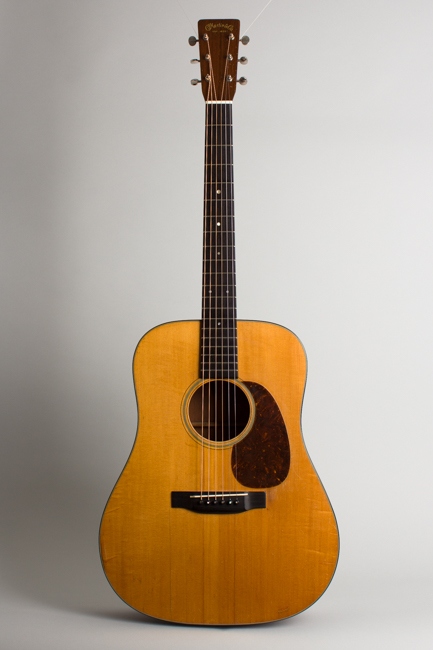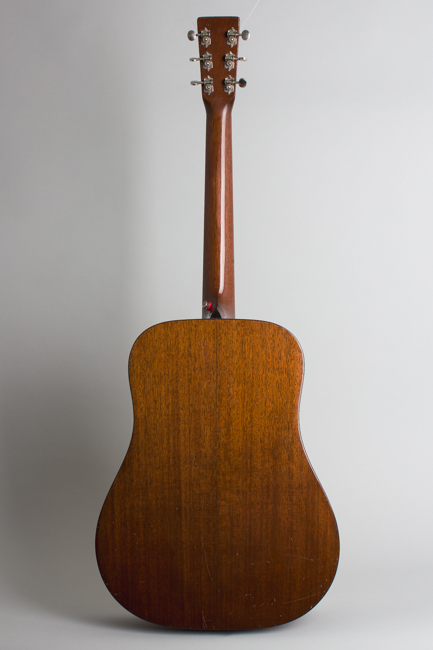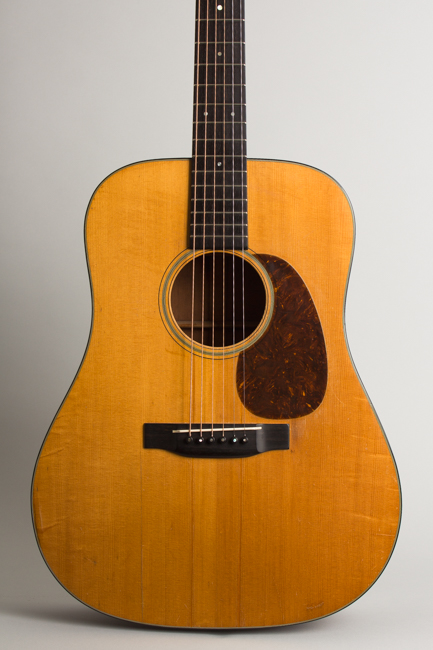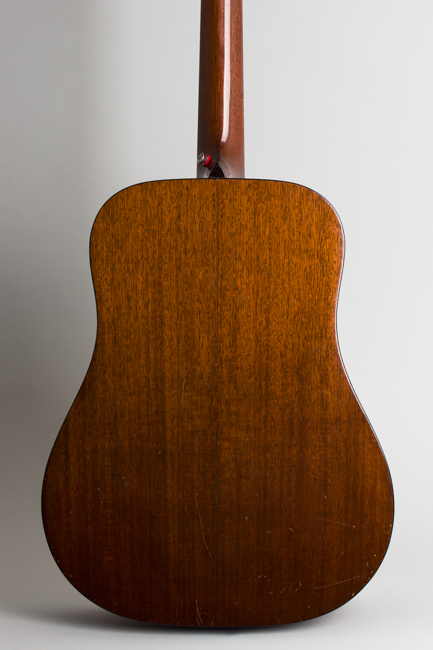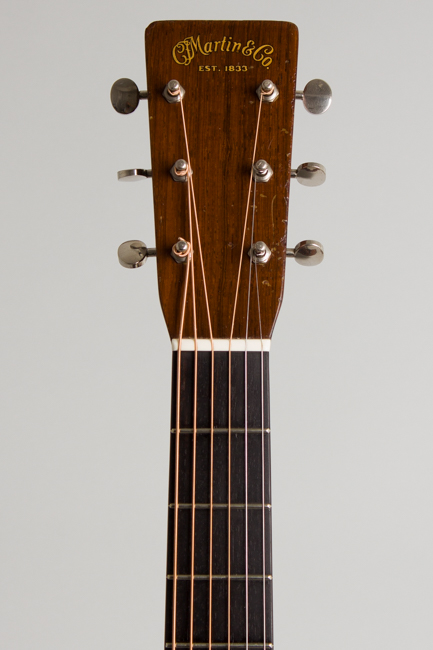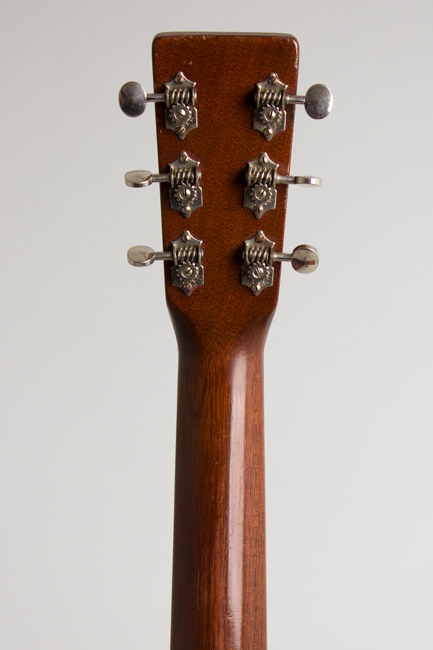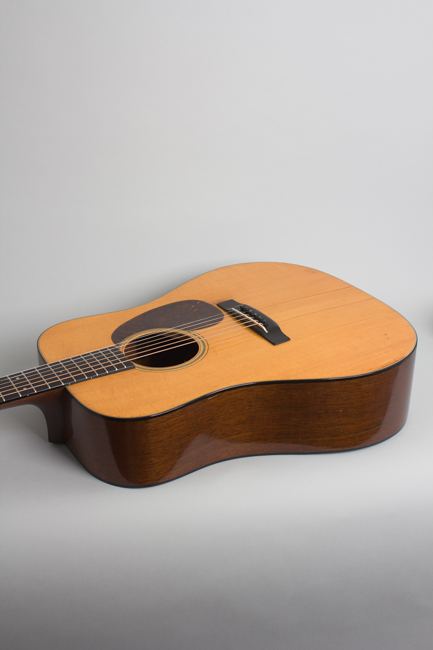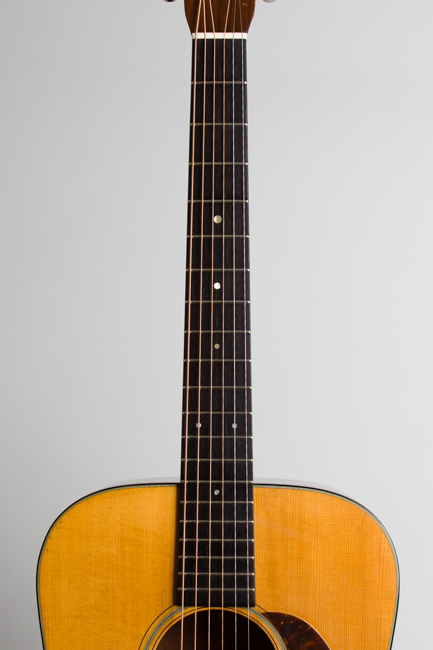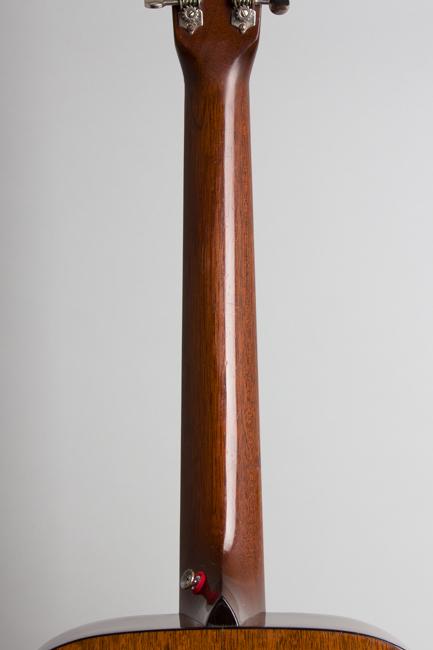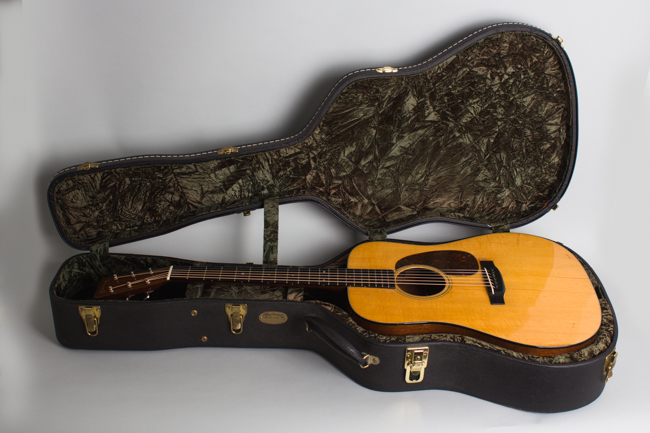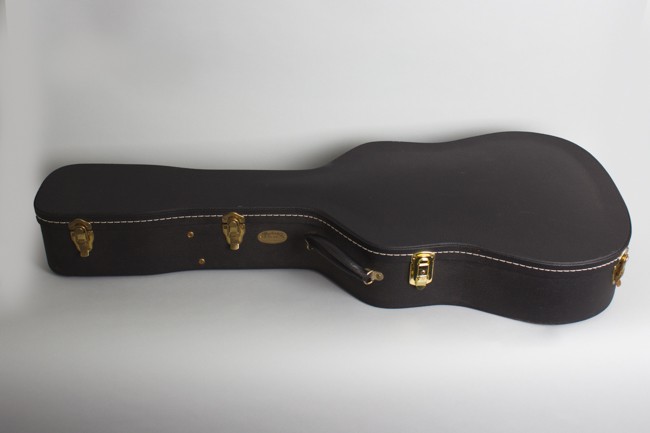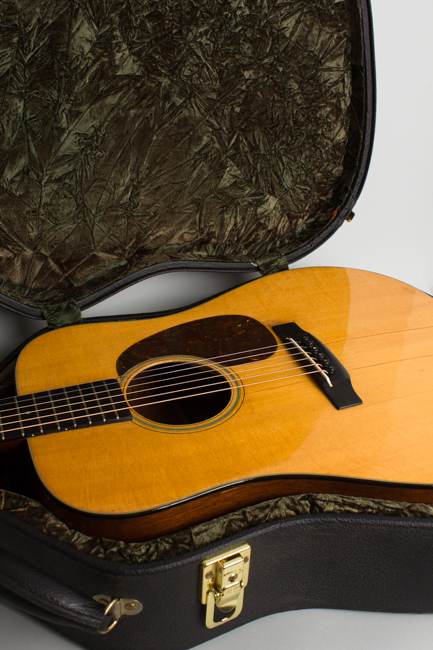C. F. Martin D-18 Flat Top Acoustic Guitar (1937)
End of Summer Sale - PRICE REDUCED!
$42,500.00 + shipping
Buy NowItem # 10887
Prices subject to change without notice.
C. F. Martin D-18 Model Flat Top Acoustic Guitar (1937), made in Nazareth, PA, serial # 68147, natural lacquer finish, Mahogany back and sides, spruce top; mahogany neck with ebony fingerboard, black tolex hard shell case.
On practically anyone's list of all time great guitars, the pre-WWII Martin D-18 Dreadnought ranks among the highest. This is a fine example of a 1937 D-18; well used but not abused, solidly repaired and a superb player with the sound these have always been prized for. There were only 426 D-18's made in 1937, which by later standards is a very small number indeed. With a list price of $65 plus case this was an expensive instrument for most players in depression era America, and many once acquired were played for decades and are far more worn than this.
This guitar was built in late 1937 with the earlier "advanced" X Bracing and wider nut that have become the connoisseur's choice features on pre-war Martin dreadnoughts. Other typical-and much desired features of the era including a close-grain Adirondack spruce top, ebony bridge and fingerboard, tortoise celluloid pickguard and binding and openback Grover G-98 "butterbean" button tuners. This neck is not only wider but also somewhat chunkier in feel than Martin necks from the next decade, with a residual "soft V" profile that becomes more prominent as the neck approaches the body.
This D-18 plays effortlessly with a smooth and powerful sound typical of these original "Golden Age" Martins. The Dreadnoughts of this era were undisputed favorites with professional Country & Western radio and stage entertainers when new, and are still known as perfect guitars for a wide range of styles. This D-18 is a fantastic recording guitar, with the mellow depth of the Dreadnought mixed with the crisp slightly dry ring of a mahogany body. This is a fairly early prewar example, expertly restored and ready for many more decades of service.
Overall length is 40 3/4 in. (103.5 cm.), 15 3/4 in. (40 cm.) wide at lower bout, and 4 15/16 in. (12.5 cm.) in depth at side, taken at the end block. Scale length is 25 1/2 in. (648 mm.). Width of nut is 1 11/16 in. (43 mm.).
This early D-18 has seen some notable repair but has survived over eight decades better than many. There are three long repaired top grain cracks, two of which run from the tailblock under the bridge to the rear edge of the soundhole ring. On each of these cracks a spline was added and carefully touched up. A third top grain crack runs from the bottom edge of the top to an area adjacent to the bass side wing of the bridge. This crack has been glued and cleated.
On the inside of the guitar, the two splines can be seen along with carefully shaped cleats along each repair. Another cleat was added at the intersection of the X-brace. This reinforces the portion of the splined crack that runs under the "B" string. A couple of tightly sealed short hairline grain cracks run for about a half an inch each on either side of the bridge, both in front and behind the bridge. The bridge itself is a carefully made reproduction of the original, matching both in contours and footprint. The bridge plate is a careful replacement, it is properly tucked in to the legs of the X-brace as an original would be and it matches the original footprint, just slightly thicker than the original. A small piece of spruce has been reattached at the front edge of the bridge ahead of the G string.
The back center seam appears to have opened a bit over time but is fully solid. A very light clear overspray has been added over most of the guitar, most noticeable on the top. The tuners are original openback Grovers. The guitar has had a clean neck set and expert refret; plenty of saddle is showing and playability is excellent. The frets have some very light wear. What may be the original nut has been re-worked and slightly shimmed up, and there is a strap button added at the heel. The finish shows some fairly light wear overall but nothing too serious, mostly dings and dents to the back and pickwear adjacent to the pickguard on all sides. The back of the neck is very clean. While showing some noticeable work to the top this is still a really fine guitar for the serious player, with the advanced X-braced sound and feel at less than top dollar for Dreadnoughts from this most exalted period. Overall Very Good + Condition.
On practically anyone's list of all time great guitars, the pre-WWII Martin D-18 Dreadnought ranks among the highest. This is a fine example of a 1937 D-18; well used but not abused, solidly repaired and a superb player with the sound these have always been prized for. There were only 426 D-18's made in 1937, which by later standards is a very small number indeed. With a list price of $65 plus case this was an expensive instrument for most players in depression era America, and many once acquired were played for decades and are far more worn than this.
This guitar was built in late 1937 with the earlier "advanced" X Bracing and wider nut that have become the connoisseur's choice features on pre-war Martin dreadnoughts. Other typical-and much desired features of the era including a close-grain Adirondack spruce top, ebony bridge and fingerboard, tortoise celluloid pickguard and binding and openback Grover G-98 "butterbean" button tuners. This neck is not only wider but also somewhat chunkier in feel than Martin necks from the next decade, with a residual "soft V" profile that becomes more prominent as the neck approaches the body.
This D-18 plays effortlessly with a smooth and powerful sound typical of these original "Golden Age" Martins. The Dreadnoughts of this era were undisputed favorites with professional Country & Western radio and stage entertainers when new, and are still known as perfect guitars for a wide range of styles. This D-18 is a fantastic recording guitar, with the mellow depth of the Dreadnought mixed with the crisp slightly dry ring of a mahogany body. This is a fairly early prewar example, expertly restored and ready for many more decades of service.
Overall length is 40 3/4 in. (103.5 cm.), 15 3/4 in. (40 cm.) wide at lower bout, and 4 15/16 in. (12.5 cm.) in depth at side, taken at the end block. Scale length is 25 1/2 in. (648 mm.). Width of nut is 1 11/16 in. (43 mm.).
This early D-18 has seen some notable repair but has survived over eight decades better than many. There are three long repaired top grain cracks, two of which run from the tailblock under the bridge to the rear edge of the soundhole ring. On each of these cracks a spline was added and carefully touched up. A third top grain crack runs from the bottom edge of the top to an area adjacent to the bass side wing of the bridge. This crack has been glued and cleated.
On the inside of the guitar, the two splines can be seen along with carefully shaped cleats along each repair. Another cleat was added at the intersection of the X-brace. This reinforces the portion of the splined crack that runs under the "B" string. A couple of tightly sealed short hairline grain cracks run for about a half an inch each on either side of the bridge, both in front and behind the bridge. The bridge itself is a carefully made reproduction of the original, matching both in contours and footprint. The bridge plate is a careful replacement, it is properly tucked in to the legs of the X-brace as an original would be and it matches the original footprint, just slightly thicker than the original. A small piece of spruce has been reattached at the front edge of the bridge ahead of the G string.
The back center seam appears to have opened a bit over time but is fully solid. A very light clear overspray has been added over most of the guitar, most noticeable on the top. The tuners are original openback Grovers. The guitar has had a clean neck set and expert refret; plenty of saddle is showing and playability is excellent. The frets have some very light wear. What may be the original nut has been re-worked and slightly shimmed up, and there is a strap button added at the heel. The finish shows some fairly light wear overall but nothing too serious, mostly dings and dents to the back and pickwear adjacent to the pickguard on all sides. The back of the neck is very clean. While showing some noticeable work to the top this is still a really fine guitar for the serious player, with the advanced X-braced sound and feel at less than top dollar for Dreadnoughts from this most exalted period. Overall Very Good + Condition.
